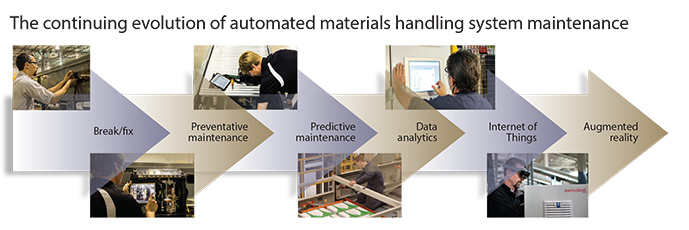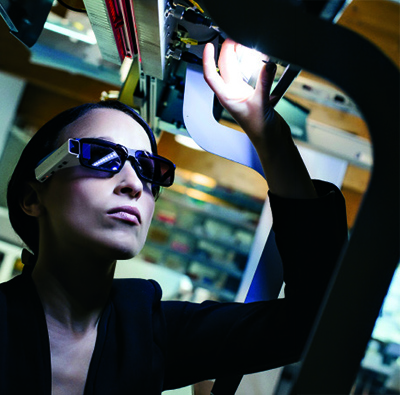Advanced Technologies Move Into Maintenance
The rate of change is picking up in the maintenance of automated materials handling systems. Now is a good time to become familiar with solutions ranging from computerized maintenance management systems to augmented reality.
There is a substantial generation gap emerging in the technology used to maintain automated materials handling systems. And it’s a gap sure to get even wider before very long.
At the recent ProMat 2017 show and in conversations with suppliers of automated systems, we found several approaches that move well beyond preventative maintenance, not to mention traditional break/fix strategies.
Relatively new but generally familiar words in this conversation now include predictive maintenance (also known as condition-based monitoring) and data analytics. Added more recently are computerized maintenance management systems (CMMS) and supervisory control and data acquisition (SCADA). All are in place today but are not yet standard in automated system maintenance.
Then, some really new entries have entered the discussion. These include: Internet of Things (IoT), augmented reality (AR) and virtual reality (VR). None of these are nearly as commonplace as the first grouping. But that’s about to change, opening up a true generation gap between maintenance technologies.
Before panic breaks out in the maintenance department, much of what is happening here is in the early stages. It is too early to start picking winners and losers among the various technologies. No need to build an ark to save selected technicians who you think have the best chance of success in this new world. But, it is time to pay attention to what is in development and being introduced by suppliers.
Getting started with CMMS, SCADA
Interestingly enough, there is scant unanimity in the development direction of these maintenance technology solutions. Each supplier is taking its own approach, and they are different.
For instance, some suppliers are building a base with CMMS and even SCADA. They say the two provide a more comprehensive framework that starts with data about the equipment and its condition. Overall supervisory management of the process is also a capability of certain solutions.

Typically, CMMS is more than just a software package that directs and manages maintenance activities. CMMS for automated systems is also capable of learning the equipment assets, their predictive maintenance schedules and reporting programs. Meanwhile, staff manages the data to ensure not just operational efficiency but better equipment life cycle management.
That final capability is the one most notably expanding CMMS and SCADA capabilities for automated systems.
“This allows automated materials handling to move beyond asset management to capital management,” says Scott Chando, a software specialist in customer service at Dematic. He adds this expansion moves from equipment management to enterprise management, including capital planning. “It’s a shift from operational monitoring to true facility planning,” says Chando.
Over at Intelligrated, Dave Trice, senior director of business development for life cycle support service, has a similar take on his company’s CMMS. “This is the shift from asset management to people and technology management,” he says. It puts the focus on equipment life cycle management and getting the right people trained to ensure equipment users are at a competitive advantage. Trice adds that the life cycle management aspect looks out not just three to five years, but 10 to 15 years.
Meanwhile, Daifuku is developing its own CMMS and SCADA combination. But the emphasis there is a little different. Randy Marble, vice president of software strategy at Daifuku’s Wynright division, says traditional asset management is morphing into proactive asset management. This means the equipment is a driver of its own needs without reliance on people or preventive maintenance programs. “It’s all about optimizing flow in the facility,” he adds.
Of course, all of this is possible because of data and data analytics—the backbone of CMMS and SCADA. And they will be taking on even greater importance as IoT and AR get established in the maintenance equation. In addition to providing historical information, these systems “provide capabilities for predictive maintenance but also provide data for making repair or replace decisions,” says Chando.
CMMS overlays the SCADA layer, which provides a visual interface to technicians. SCADA receives information primarily from programmable logic controllers (PLC) today with occasional data collection devices including sensors at various points in the materials handling system.
Today, a more traditional data network feeds the information to SCADA for analysis and CMMS decisions. As new devices that are not PLCs are added, the network will be modified to fit more of the profile of what is typically called an IoT. No one at this point is predicting a trajectory for that transition.
But it is coming, and there is already a sharp focus on cybersecurity. The typical intent here is to lock down networks and limit outside access even in the Cloud, says Chando. Dematic, in particular, is interested in building out the IoT on automated materials handling systems without interfering with what is already in place. Suppliers are in the early stages of designing fully integrated data networks that are segregated from existing data infrastructure.
AR will change the industry
So far, the emphasis on advanced maintenance systems has been on monitoring systems and determining what needs to be fixed and when. Suppliers are now at a point of turning to augmented reality to actually aid technicians in making the necessary repairs.
“Augmented reality will change the industry,” says Mike Howes, vice president of the software and controls hub for the Americas region at Swisslog. And he is not alone in that assessment. Kevin Reader, director of business development and marketing at Knapp, has equally high expectations.
Both companies are using AR to guide maintenance activities at various materials handling system installations. In the case of Knapp, the AR works hand-in-hand with SCADA systems.
Both systems work much the same. Technicians on-site wear AR goggles that show a remote Help Desk to see what the technician is seeing with audio communications. AR allows the system to display in the goggles for the technician the schematics of the motor, conveyor, robot or other equipment. Then the schematic can be exploded, spun and otherwise manipulated to guide the technician on the repair.
“The idea here is to provide a single event resolution for complex systems,” says Reader. “If you can reduce downtime in a facility by 1% to 2%, you have a home run in productivity gains.” The Knapp AR maintenance system, by the way, is an extension of its visualization system used for picking.
Reader adds that some clients are interested in running the entire system internally. That setup would eliminate the need to have Knapp technicians involved, further consolidating the steps needed to resolve problems and get systems back up and running.
Reader sees smaller, lighter, faster goggles in the future for this technology. Howes sees iPads in the mix. With the goggles and iPad linked, techs would be able to receive data directly from system sensors and see trouble spots highlighted on the iPad. Then the googles would guide the repair steps as they do now.
Where VR fits
Then there’s the matter of virtual reality. No one sees VR as part of the hands-on maintenance solution at this point. The technology is just not well suited to the application. However, there are other opportunities for VR to have an indirect impact on maintenance activities.
For instance, VR for lift truck operator training was on display at ProMat 2017 at both the Yale and The Raymond Corp. booths. This is an opportunity to further improve operator training that will result in greater safety and reduce related maintenance requirements.
OSHA lift truck operator requirements still require classroom instruction and facility operator training. VR fits in between those two, says Dave Norton, vice president of corporate quality and customer care at Raymond.
It works this way: An operator wears the goggles while standing on a completely stationary truck. An instructor then runs programmed lessons that the operator sees in the goggles for activities from product pickup to driving down a warehouse aisle. VR also affords the instructor a view of the operator in detail never before possible, all the way down to the movement of the operator’s eyes. Norton says this allows reinforcement of proper behaviors by operators and shortens training time.
At the system level, VR may well have a role in the makeup of a facility. Swisslog’s Howes calls it the next evolution of system simulation. “We can use it to show how a distribution center should look in one, three or five years,” he says.
“With VR, you can create and walk through a facility without ever bolting anything to the floor. It will help us get to the right solutions more quickly,” Howes says.
VR also allows systems to provide a playback of how a system operates in real time. Howes says this gives a visual of what’s happening rather than just crunching data. In addition to improving operations, this approach has the potential to offer a window into potential maintenance issues that can be minimized or eliminated altogether.
Clearly, materials handling maintenance capabilities are moving in a very high tech direction. And, none too soon. The pressures of keeping systems up and running 24/7 today are so intense it won’t be long before these advances don’t feel quite so advanced anymore.
Companies mentioned in this article:













